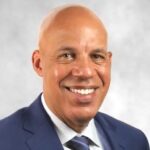Frequent and enthusiastic communication is Superintendent Adam Clark’s top tool in maintaining enrollment at the Mt. Diablo Unified School District in Northern California.

From student safety to political divisiveness, the challenges K12 education is facing are only exaggerated when leaders fail to get the message out about their “successes and services,” says Clark, who was named a Superintendent to Watch by the National School Public Relations Association.
“Communications is one of the things within the superintendent’s role that is critical to advocating for your district,” Clark says. “A way to combat declining enrollment is to communicate about the different programs available—some folks may not know exactly all that we have to offer.”
More from DA: How 2 new principals are reinventing the beginning of the school year
Mt. Diablo Unified School District chronicles the achievements of its 29,000 students, 3,500 employees and 55 schools in its regular Friday newsletter that, in the name of transparency, also includes the updates Clark solicits from his department heads and then conveys to the school board.
He frequently speaks to community groups and at PTA meetings and school activities. He (@mraclark29) and @MtDiabloUSD both maintain active accounts on X (formerly known as Twitter). The district also has an extensive communications platform that allows leaders, teachers and others to communicate directly with groups of parents and individual families. And Clark wants the district website to be up-to-date at all times so that students, parents and communication members can always access the information they need.
Because misinformation and rumors can also eat away at enrollment, dispelling them is another force behind Clark’s comprehensive approach to communications, whether he’s in front of a TV camera or being interviewed by a reporter. “When we have challenges, when we have success, I’m out speaking about those things,” he explains. “I’m putting out the position of the district, and putting the actual facts out there and not letting rumors on the internet, reader comments and things like that dictate our narrative.”
Throughout all district communications, Clark works to ensure all messages are tied to Mt. Diablo Unified School District’s Mission and Vision statement, which comprises high academic expectations, cultural competence, family engagement and inclusivity. “It creates a common message that everybody hears,” he points out. “In these challenging days, we in public education have to go above and beyond to advocate for the needs of our young people.”
How politics complicate school communications
Political divisiveness that seems to be ever-intensifying is complicating communications efforts in Mt. Diablo and across the nation. When it comes to safety, for example, a significant portion of many communities wants to harden schools with armed guards and even armed teachers. But many others want educators to focus on student voice and choice, mental health and social-emotional learning.
Like in many districts, Mt. Diablo’s educators are now having to cope with “warfare” on the LGBTQ students and communities after facing conflict over critical race theory, masks and COVID vaccines. “Schools and school districts are just a reflection of our society—when these battles are taking place they bleed over into the school arena, and superintendents or principals or teachers find ourselves caught in the middle,” Clark says. “Instead of just teaching academics and really focusing on that we’re pulled into these polar opposite viewpoints that in some cases can be very distributing and very negative interactions.”
He also worries about the difficulties some of his students face in achieving “that American Dream” as college costs increase and they contend with the social pressures of a divided society. “How are they going to go into an environment that maybe doesn’t accept who they are and where they come from,” he continues. “I really worry about our students when they leave our system and if they’re going to be treated with the care and warmth they experienced while they were with us.”
Still, he remains optimistic about the larger-than-expected enrollment in the district’s pre-K programs and its rich slate of extracurricular activities. “We have our students back on campus each and every day after the last couple of years have been touch and go,” he concludes. “Each day I can go out to a school site and see our students in class with their friends and learning from their teachers provides tremendous excitement.”









